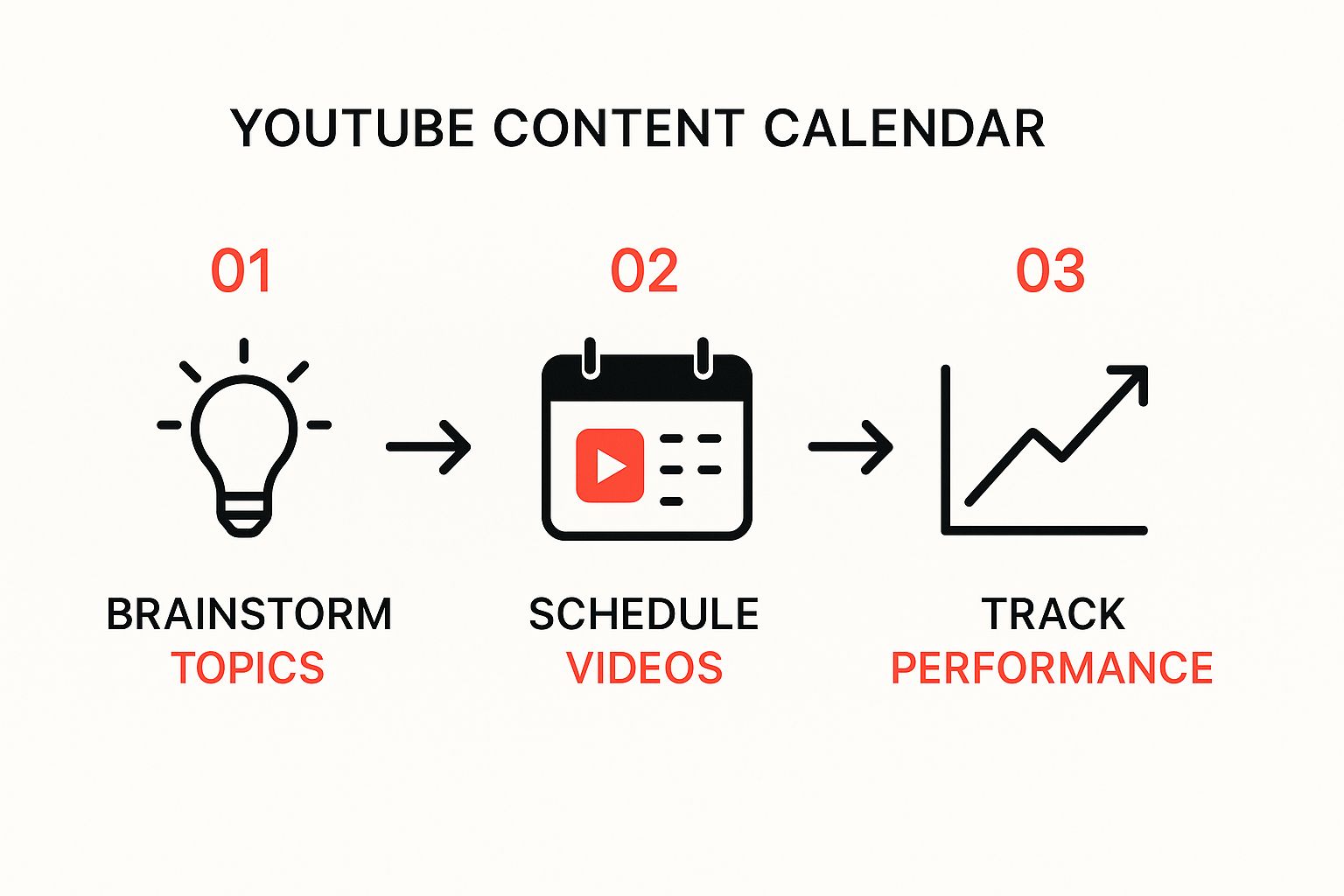Why Your YouTube Channel Desperately Needs A Content Calendar

Let's be honest. Posting a video only when you feel a sudden burst of inspiration sounds romantic, but it's a quick way to burn out and watch your channel flatline. Too many creators think this spontaneous approach is the secret to authenticity. The reality? The most successful channels run less like a chaotic artist's studio and more like a dependable TV network.
A YouTube content calendar template is what bridges that gap. It's the strategic tool that turns your channel from a random assortment of videos into a brand people can rely on. Think of it as a roadmap for growing your audience and, maybe more importantly, keeping your sanity.
The Hidden Cost of ‘Winging It’
Running your channel without a plan has real consequences that go way beyond feeling a little disorganized. This "just film something" method actively sabotages your channel's momentum. Posting at random confuses the YouTube algorithm, which is built to reward consistency. Even worse, it's a confusing experience for your viewers.
The true costs of winging it are steep:
- Creative Burnout: The constant pressure to decide what to film next drains your mental energy, leaving little left for producing great content.
- Lost Momentum: Without a schedule, you can't plan for holidays, tap into trending topics, or create seasonal videos that are relevant to your audience.
- Pointless Effort: When your videos don't connect to a larger strategy, they often underperform. This can make all your hard work feel like it was for nothing.
This endless cycle of scrambling for ideas and publishing whenever you can is a major reason why so many creators eventually give up.
Building Audience Trust Through Predictability
Your viewers want to know what to expect. It's like tuning in for your favorite show every week—they learn to anticipate your uploads and make them part of their routine. A content calendar helps you create this rhythm, which is key to turning casual viewers into a loyal community.
When they know a new video is on its way, they build a habit around you. This is how you stand out. As of 2025, YouTube has 2.74 billion monthly active users. A predictable schedule is your best tool for cutting through that noise. You can explore more surprising YouTube statistics here.
Ultimately, having this structure isn't just about scheduling. It’s about building a sustainable operation. Consistent, quality videos are the foundation of growth and a must if you want to meet your revenue goals. If you're serious about taking that next step, you can learn more about what it takes in our guide on YouTube monetization requirements. A well-kept calendar is the first step in turning your passion into a profession.
Building Your YouTube Content Calendar Foundation
 A good template is a great start, but it's the strategy behind it that truly drives growth. Think of it this way: a fancy calendar is just an empty grid without a solid plan. The foundation of a powerful YouTube content calendar template isn’t about the software you pick, but the strategic thinking you invest before you even schedule your first video. This groundwork ensures every piece of content has a clear purpose and a path to success.
A good template is a great start, but it's the strategy behind it that truly drives growth. Think of it this way: a fancy calendar is just an empty grid without a solid plan. The foundation of a powerful YouTube content calendar template isn’t about the software you pick, but the strategic thinking you invest before you even schedule your first video. This groundwork ensures every piece of content has a clear purpose and a path to success.
Discover Your Content Pillars
Before you can fill a calendar, you need to know what you’re actually making. This is where content pillars become your best friend. These are the 3-5 core topics or themes that your channel is built around. For a cooking channel, your pillars might be "30-Minute Meals," "Baking for Beginners," and "Global Cuisine Adventures." These pillars give your channel a clear identity and keep your content focused.
The best way to find your pillars is to listen to your audience. Dive into your YouTube Analytics and see what’s already working. Which videos get the most views? Which ones have the highest engagement? If your viewers go wild for your product reviews but snooze through your vlogs, you've just found a crucial clue. Building your schedule around these proven topics means you're creating content you know your audience wants to see.
To help you decide on the right mix, it's useful to compare different pillar strategies. Not all content types serve the same purpose, and the table below breaks down how each one can work for various channels.
Content Pillar Planning Framework
A comparison of different content pillar strategies and their effectiveness for various channel types
| Content Pillar Type | Best For | Posting Frequency | Engagement Potential |
|---|---|---|---|
| How-To/Tutorials | Educational, DIY, tech, and software channels | Weekly to bi-weekly | High (strong for saves, shares, and search traffic) |
| Reviews/Unboxings | Tech, beauty, gaming, and product-focused channels | 1-2 times per week | High (drives comments, affiliate clicks, and opinions) |
| Commentary/Reaction | Gaming, news, pop culture, and entertainment channels | 2-3 times per week or daily | Very High (sparks debate, comments, and quick views) |
| Vlogs/Behind-the-Scenes | Lifestyle, travel, and personality-driven channels | 1-3 times per week | High (builds deep community connection and loyalty) |
As you can see, a how-to video might have a longer shelf life and pull in search traffic for years, while a commentary video can create a huge spike in immediate engagement. A healthy channel often mixes these types to keep things fresh for the audience and manageable for the creator.
Understand Your Audience's Rhythm
Posting a fantastic video when no one is around to watch it is like throwing a party and forgetting to send invitations. You'll hear a lot of general advice about the "best time to post on YouTube," but most of it is useless because your audience is unique. You need to find their rhythm, not someone else's.
Luckily, YouTube gives you this data directly. Inside YouTube Studio, head to the 'Audience' tab and look for the chart titled "When your viewers are on YouTube." This isn't a guess; it's a heatmap of your audience's activity.
If the chart is glowing bright purple on Wednesdays at 7 PM, that's your primetime. That's when your community is online and ready for new content. Scheduling your uploads for these peak hours gives your videos an instant viewership boost, which signals to the algorithm that your video is worth showing to more people.
Map a Sustainable Workflow
Finally, your calendar needs to be realistic for you and your resources. It’s a common mistake to model your workflow after a creator who has a full production team when you're flying solo. The goal is sustainability, not burnout. A smart workflow balances two types of content:
- Evergreen Content: These are your foundational videos, like an in-depth guide or a tutorial that will stay relevant and pull in views for years.
- Trending Content: These are timely videos that tap into current events or popular topics, providing quick bursts of traffic and visibility.
Be honest with yourself and map out how long each stage of production actually takes. Consider everything from research and scripting to filming, editing, and creating the thumbnail. Understanding your real-world capacity is what transforms a wishful-thinking calendar into a practical tool you can stick with for the long haul.
Creating Your Custom YouTube Content Calendar Template
Once your core strategy is locked in, it’s time to build the tool that brings it to life. A generic template is a fine place to start, but a truly custom YouTube content calendar template acts as an extension of your creative brain, built specifically for your unique workflow. The goal here is to create a system that tracks a video through every single stage of its life.
This simple flow shows the basic journey a video takes within your calendar, from a spark of an idea to the final performance review.

This makes it clear that a calendar is much more than a schedule—it’s a production system that guides your content from concept to completion and beyond.
The Core Building Blocks of Your Calendar
A good calendar needs to track a lot more than just the upload date. Think of it as the project management dashboard for your entire channel. Whether you're building this in a spreadsheet or a tool like Airtable, your template should cover the video's whole journey. At a minimum, make sure you have columns or fields for these items:
- Video Title (Working & Final): Have one spot for the rough idea and another for the final, SEO-friendly title you land on.
- Content Pillar: Which of your main channel themes does this video fit into? This keeps your content focused.
- Status: This is your most important field for seeing progress at a glance. Use simple, clear labels like ‘Idea,’ ‘Scripting,’ ‘Filming,’ ‘Editing,’ ‘Scheduled,’ and ‘Published.’
- Key Dates: Don't just track the publish date. Set separate, realistic deadlines for the script, filming day, and the final cut.
- Primary Keyword: What's the main search term you hope people will use to find this video?
- Thumbnail Concept: Jot down a quick description or link to a design draft. The thumbnail is too important to be an afterthought.
- Call-to-Action (CTA): What specific action do you want your viewers to take? Subscribe? Check out your merch? Visit a link in the description?
- Post-Publish Checklist: The work isn't done when you hit publish. This list can include tasks like pinning a top comment, sharing the video on social media, or adding it to a relevant playlist.
Putting these pieces together turns a simple schedule into a strategic command center. You can spot potential delays before they happen and make sure no critical steps get missed.
Choosing Your Tool and Customizing It
You don't need to spend a lot of money on fancy software. Many of the biggest creators run their channels from a well-organized spreadsheet. If you're more of a visual planner, a digital calendar can do the trick. For instance, you can use Google Calendar and color-code different entries to represent the stages of your content.

This kind of visual separation lets you see your entire production pipeline in a single view, showing what’s being scripted (blue), what’s published (green), and everything in between.
The real power comes from customization. A gaming creator might add a field for "B-Roll Footage Captured," while a cooking channel might need a checklist for "Ingredients Sourced." If you're working with a team, add columns for ‘Assigned To’ and ‘Editor’s Notes’ to keep everyone on the same page without endless email chains.
The best calendar is one that grows with you, so don't be afraid to add, remove, or tweak fields as you figure out what works. I highly recommend leaving a few "TBD" slots open each month. This gives you the breathing room to jump on a trending topic or a sudden viral opportunity without wrecking your whole schedule. Planning for spontaneity is what separates good creators from great ones.
Essential Elements That Make Your Calendar Actually Useful
A pretty calendar is one thing, but a useful one is something else entirely. Its real power is unlocked when it stops being a simple schedule and becomes the command center for your entire content operation. This is how you guide a video from a simple idea to a fully promoted piece of content. It’s about building a dashboard that tracks more than just publish dates.The biggest difference between a casual creator's calendar and a professional one is the level of detail. These details are what prevent those last-minute scrambles and make sure every video has a solid strategy before you even think about hitting record. If you're building your YouTube content calendar template from scratch, checking out a general social media calendar template can give you some great ideas on how to structure your workflow.
Core Information for Every Video
To get the most out of your calendar, each entry should act as a mini-brief for your video. This is about more than just a working title; it's about having all the key information in one place so your upload process is smooth and thought out.
Your calendar needs a spot for these essentials:
- Your SEO Plan: Don't just pick a topic; identify the primary target keyword you want to rank for, plus a few secondary ones. This makes your content discoverable from the get-go.
- Ready-to-Go Metadata: Have fields for your final, SEO-friendly title, a draft of the video description, and a list of your main tags. Prepping this ahead of time saves a surprising amount of stress on upload day.
- A Thumbnail Strategy: A field for your thumbnail concept is absolutely essential. Briefly describe the planned layout, text, and images. A killer thumbnail is usually planned long before the video hits the editing software.
- A Clear Call to Action (CTA): What do you want your viewers to do after watching? Define the specific CTA, whether it’s subscribing to your channel, watching another video, or clicking a link in the description.
Mapping Out the Full Production Cycle
A calendar that only shows the publish date is a recipe for chaos. Real content management means mapping out the entire production timeline to build a workflow you can actually stick to. This is how you break the cycle of panic-filming and editing the night before a video is supposed to go live.
Break down every video into its own production phases, each with its own deadline right in the calendar:
- Research & Scripting Due Date: The deadline for getting the video's core message and outline finalized.
- Filming Date: The day you’ve set aside to actually shoot the footage.
- Editing & First Cut Deadline: The target for having a complete draft ready for you or your team to review.
- Final Approval & Scheduling Date: The day the finished video gets uploaded and scheduled for its big debut.
If you’re working in a team, adding a column for ‘Assigned To’ or ‘Status’ (for example, In Editing, Awaiting Thumbnail) is a game-changer. It keeps everyone on the same page without needing a hundred back-and-forth emails. This is the kind of detail that separates stressed-out creators from professional content producers.
Optimizing Your Content Strategy Through Calendar Intelligence
 The real power of your content calendar appears when you treat it as more than just a schedule. Think of it as your strategic command center, a living document that provides intelligence to guide every video you make. This shift in mindset is what helps a channel grow consistently instead of hitting a frustrating plateau.
The real power of your content calendar appears when you treat it as more than just a schedule. Think of it as your strategic command center, a living document that provides intelligence to guide every video you make. This shift in mindset is what helps a channel grow consistently instead of hitting a frustrating plateau.
From Scheduling to Real Strategy
This is the point where your YouTube content calendar template becomes a performance analysis tool. Instead of just looking forward, look back at your published videos. Which ones consistently crushed your view goals within the first 48 hours? Which thumbnails had the best click-through rates?
By noting these successes and failures directly in your calendar, you start to see patterns you’d otherwise miss. For example, you might realize that your tutorials under 10 minutes published on Fridays always outperform your vlogs. That’s not a guess; it's a data-backed strategy pulled from your own channel’s performance.
Identifying Content Gaps and Opportunities
A well-maintained calendar also highlights what you haven't been doing. If you color-code your main content pillars, you can spot imbalances at a glance. You might see that you’ve done five product reviews this month but haven’t posted a single tutorial, even though tutorials are what bring in the most subscribers.
This visual cue acts as a powerful nudge to balance your content mix. This kind of forward-thinking planning is about building a strong video library. To make sure nothing slips through the cracks, you can integrate your planning with other tools; for example, you can learn how to add tasks to your Google Calendar to turn these identified gaps into concrete action items.
This level of detailed analysis is so important because it’s tough to get noticed on YouTube. The average engagement rate on the platform hovers around a mere 3.87%, which means most viewers are just passively watching. Your best shot at beating that average is to create targeted content based on what you already know works for your audience. You can discover more essential YouTube stats here.
Balancing Algorithm and Authenticity
A smart calendar helps you find the sweet spot between videos the algorithm favors and content your community is asking for. You can intentionally schedule high-search-volume evergreen videos that will attract new viewers over the long term.
At the same time, you can slot in community-focused videos like Q&As or behind-the-scenes content that builds incredible loyalty with your existing subscribers. This strategic blend is what fuels both growth and retention—the two pillars of a sustainable YouTube channel. Finding this balance is also a big part of effective monetization. For more on that, take a look at our guide on how to make money on YouTube with ads.
Tools And Workflows That Streamline Your Content Planning
A fantastic YouTube content calendar template is a great start, but it’s the system behind it that truly makes the difference. The best tool isn't the most complicated or expensive one; it's the one that fits into your creative flow without causing friction. You need to find a command center that works for you, whether that's a simple spreadsheet or a feature-packed platform.
From Humble Spreadsheets to Powerful Platforms
When you're just starting out, a free tool like Google Sheets is often all you need. It’s incredibly flexible, simple to share, and costs absolutely nothing. You can build a surprisingly effective system using different tabs for ideas and analytics, and even use conditional formatting to create visual status trackers.
As your channel grows, or if you bring on a team, you might start to feel the limitations of a basic spreadsheet. That's when project management tools such as monday.com or Airtable become really useful. They provide visual Kanban boards, send out automatic notifications, and connect with other apps to keep everyone on the same page.
To help you decide what might be the right fit for your channel, here is a quick comparison of some popular options.
YouTube Content Calendar Tools Comparison
Detailed comparison of popular tools for managing YouTube content calendars, including features, pricing, and best use cases
| Tool Name | Best Features | Pricing | Best For | Integration Options |
|---|---|---|---|---|
| Google Sheets | Free, highly customizable, easy collaboration | Free | Solo creators & small teams on a budget | Limited (requires manual linking or third-party tools) |
| Airtable | Powerful databases, custom views, automation | Freemium, paid plans from ~$20/mo | Creators needing flexibility & data tracking | Extensive (Slack, Google Drive, social media) |
| monday.com | Visual dashboards, workflow automation, team management | Paid plans from ~$9/seat/mo | Teams needing clear project oversight | Strong (Adobe Creative Cloud, Mailchimp, Zapier) |
Ultimately, the choice depends on your specific needs. Don't feel pressured to use a complex tool if a simple spreadsheet does the job. You can always upgrade later when your workflow demands it.
Building an Efficient Content Ecosystem
Your content calendar shouldn't exist in a vacuum. Real efficiency happens when you connect it with the other tools you use every day. Think of your calendar as the central hub of your production process. You can link directly to Google Drive folders that hold your video scripts or raw footage, or even embed Figma links for your thumbnail designs right into the calendar entry.
This approach transforms your calendar from a simple schedule into a living project brief for every single video. If you really want to take things up a notch, automation is your best friend. With a service like Zapier, you can create triggers that do the work for you. For instance, when you drag a video card to your 'Editing' column, it could automatically create a task for your thumbnail designer in their favorite app. This gets rid of manual check-ins and keeps production moving smoothly.
The goal is to build a system that handles the busywork, giving you more time to focus on creating great videos. You can find more ideas on how to boost your YouTube video production workflow today in our other guide.
Don't overlook the small details that prevent major headaches later. Set up smart notifications to remind you or your team about deadlines, but make sure they’re targeted. A weekly digest email or a specific Slack message is much more effective than a constant stream of alerts that just becomes background noise. Finally, have a simple backup plan. Even with reliable cloud tools, exporting your calendar as a CSV file once a month is a five-minute task that can save you from losing hours of planning to an unexpected glitch.
Your Action Plan For Content Calendar Success
Alright, you've got the template and the theory down. But knowing the path is different from walking it. This is where the real growth happens—by turning your plan into action. Moving from posting on a whim to a structured schedule can feel like a huge leap, so let's make it manageable.
Don't try to plan the entire year right now. Just focus on mapping out your next two weeks in your new YouTube content calendar template. This simple approach helps you build the habit of planning without feeling like you've suffocated your creativity. The goal here isn't perfection; it's consistency.
Monthly and Quarterly Check-ins
A content calendar that never changes is a plan that's already out of date. To stay effective, your system needs to breathe and adapt along with your channel. Think of these check-ins as your regular strategy sessions to make sure you're working smarter, not just harder. You'll be making decisions based on what your audience is actually telling you through data.
Here’s a simple rhythm you can follow:
- Monthly Review: Once a month, take a look at how your videos performed over the last 30 days. Pay close attention to your click-through rate (CTR) and average view duration. Which topics got people to click and stick around? Use what you learn to guide your content choices for the upcoming month.
- Quarterly Review: Every three months, zoom out and look at the big picture. Are you on pace to hit your subscriber goals? Are your main content pillars still pulling their weight, or is it time to experiment with a new one? This is where you make those larger, strategic shifts.
As your channel grows, you'll want to find ways to make your workflow more efficient. To keep things running smoothly, you can link your calendar to other platforms. For some great ideas on how to do this, check out this guide on how to Automate with Zapier and Buffer. Using tools like Zapier or Buffer can help you manage the load as you scale.
Ready to fast-track your journey and focus completely on making amazing videos? A pre-monetized YouTube account from MonetizedProfiles lets you bypass the initial grind and start earning from your very first video. Check out our ready-to-go accounts today!








